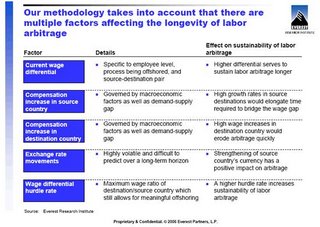While the popular concern about talent availability in India is talked often, the wachovia weekly services report declares that resource availability for top tier Indian headquartered offshoring companies shall be a manageable risk while it has to be noted that the US headquartered service companies are ramping up their offshore presence quite significantly.
Very recently when covering the Mckinsey -Nasscom study on looming Indian IT labour shortage, I wrote that the problem is not non - fixable & that with concerted efforts from Government, educational institutions & corporates.
The Everest Research Institute predicts the wage differentials will remain attractive for the next 20 years in most locales.
- Labor arbitrage is dependent on more than just wage inflation in the offshore location. An analysis of other factors led the Institute to predict offshore will make economic sense for quite awhile.
- While labor arbitrage is currently the core of the offshore value proposition, other factors-like productivity increases-will become increasingly predominant, and further increase the viability of offshoring.
The findings are based on many factors that include the recognition that wage changes need to be measured at various levels and the level inflation is more relevant than individual inflation as well as the fact that macroeconomic and currency exchange rates clearly favour offshoring as the currencies of developed countries will continue to strengthen against those of developing countries.. The study points out that the reported numbers often talk about the maximum wage inflation in an area rather than the corrected average numbers. For example, in Indian call centers last year, senior customer care executives enjoyed the largest rise in wages: 13 percent. But the vast majority of employees (over 60 percent) are entry-level staffers; their wages rose just six percent. So the average wage inflation at call centers was much more muted than widely reported. An interesting study – I can confirm based on practical experience with smart recruitment teams – scaling up even in current times in India is certainly happening at healthy rates. Time to focus on offshoring producing spectacular game changing results and pathbreaking innovation
|

